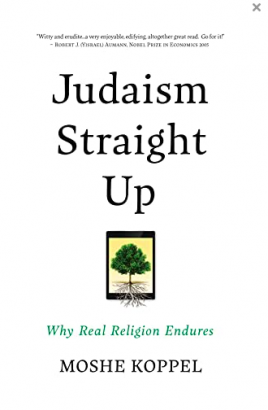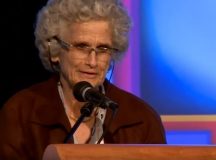Professor Moshe Koppel is the founder and executive chairman of Forum Kohelet, an influential think tank instrumental in formulating, and lobbying for, the controversial Nation State Law, currently being challenged in Israel’s Supreme Court.
In his latest book, Judaism Straight Up, Why Real Religion Endures (Maggid, 2020), he refers repeatedly to a search for a point of ‘equilibrium’ able to keep Jewish communities, and by inference Israel itself, on an even keel. Much of the book focuses on models of Jewish life and identity in the United States. I will set out below why I am not convinced that Judaism Straight Up actually presents a viable model, and certainly not for all times and places. Towards the end of the book we are presented with the claim that a new organic form of Judaism is emerging in Israel and it may reach a new equilibrium point after 2,000 years of exilic existence.
Koppel’s worldview puts ideology in the back seat. For him, ‘what works’ is what is good. The question of why we should sustain Judaism is separated from the question of how it is best sustained. In line with that choice I will only address the second question here, even though we need to debate the first as a priority. At some point we will have to consider what makes Judaism good and let that directs us to what might make it work.
Shimen and Heidi
Koppel uses the device of semi-fictional characters to promote his notion of a viable model for Jewish existence. We are introduced to Shimen and Heidi, who will stay with us more or less throughout the book. Shimen is an aging Holocaust survivor, religiously observant, and although Hasidic, he has fewer of those external trappings we normally associate with the more closed Hasidic communities. Heidi grew up in an Orthodox Jewish household, but has become distanced from the traditions she grew up with, as they have come into conflict with her modern and liberal values. Seemingly based on real people (a friend of Moshe’s grandfather and a student he met at Princeton) they are used as vehicles by Koppel to present his central thesis: Shimen’s community, and his form of Judaism, is viable, while Heidi’s world of universal values and statism are not. As for Amber, Heidi’s daughter, we are given a most troubled and rather off-putting character.
I set out reading the book with high expectations that Shimen’s intuitive Judaism, or as Rabbi Elli Fischer put it in his Lehrhaus review ‘The Torah of the Kishkes,’ would convince as a successful and sustainable model for Judaism. The reality is that Koppel himself reveals that the shteibel and kugel culture is no more sustainable than many other religious models. Shimen has no surviving children, they having been murdered in the Holocaust, and hence we can’t know really whether his Judaism can be transferred across the generations. In the book we are offered a metaphor for the location Shimen finds himself on: a narrow ‘cultural’ ridge which falls away steeply on either side. Shimen and the idealised form of Judaism that he represents is placed unsteadily at the apex of this ridge, but the next generation will not be able be stay there. We are introduced to Yitzy and Ben, characters who could easily have been his children, but we see both slide from the narrow apex of this cultural ridge to the religious and social left and right. Yitzy withdraws to Brooklyn moving behind the defensive walls of Haredi society with minimal engagement in the outside world, while Ben becomes a substantially acculturated modern orthodox Jew, his Judaism very much a second language, secondary to his commitment to profession and liberal values.
Judaism Straight Up combines the stories of Shimen and Heidi with ideas from moral psychology, philosophy and logic, to set out a sophisticated argument for an intuitive kind of religion that acts on us more like a first language rather than a set of laws and dogmas. Koppel seeks a community-based Judaism able to navigate between a fealty to tradition and a functional engagement with modernity.
And there is surely much to commend this effort to highlight communitarian ideas as a solution to the moral and social ills of 2021. Somewhat more concisely than Rabbi Sacks’ Morality, Koppel uses the image of Heidi leaving her Jewish tradition behind to examine what ails the Jews of postmodern North America as their heritage and tradition is gradually replaced by a statism based on an abstract set of universal values. He argues that this switch to universal values, this turning away from the traditional communal values cannot sustain itself, whereas a community based on the intuitive values Shimen received from previous generations will possess the social capital to do so. Shimen’s experience of Judaism, with its low centre of gravity, can bend to, but survive the buffeting of modernity, even if it sometimes gets out of balance. Heidi’s way of life does not enjoy such resilience.
We should dwell for a moment on the anti-hero of our story, Heidi. She grows up in an Orthodox family, but gradually becomes estranged from her Jewish roots. She finds it hard and eventually impossible to square her views, informed as they are by modern liberal American society, with the Orthodox Jewish approach to feminism, non-Jews and a slew of other things. To use the terminology of Jonathan Haidt, we can say she switches attaching importance to loyalty and purity and fairness to a commitment to fairness alone. In Haidt’s terms, embraced by Koppel, this is the transition from conservative to liberal morality.
Prof. Koppel tells us that he ‘will try throughout to represent Heidi’s views fairly’ but the book paints a fairly negative and patronising picture which only gets worse when we meet Amber, Heidi’s daughter, who, without Heidi’s memory of Jewishness, ends up (seemingly inevitably) as a Judaism-hating, Israel-loathing globalist seeking to tear down all the very institutions that Shimen stands for, and which he suggests Heidi herself still, deep down, identifies with. There is little agency here, just inevitable moral decay.
This is an unscrupulous pessimism. The regression from Heidi to Amber is not inevitable. There other many alternatives for liberal Jews in America. Not all millennial American Jews become super-angry or join the radical intersectional circles. Ultimately, the book lacks nuance.
Moving back to Shimen, one cannot but feel sympathy for this lovable grandpa figure, who having lost most of his close family in the Holocaust, rebuilds his life on the Upper West Side of Manhattan, attending a shteibl for the remainder of his days. Although not an exact replica of what he might have attended in pre-war Poland the synagogue reminds us of all the good things that were destroyed in Europe. The kugel, the nigunim, the communal intimacy, the simple adherence to Jewish practice, all are captured in Judaism Straight Up.
Shimen’s own grandfather is most likely to have grown up in 19th century Eastern Europe. He may have been similar to Anatevka’s Tevye, Shlomo Aleichem’s famed narrating character who became the ‘Fiddler on the Roof’, or to an urbanised Jew in Warsaw. But what we do know is the Judaism that was passed across the generations for hundreds of years struggled to cope with the onslaught of modernity, scientific thought, and modern political ideas. Modernity ravaged the Orthodox communities. Before Reform or Conservative Judaism even existed, there was the mass exodus from the ghetto communities to the outside world, academia and to acceptance by their European peers.
The equilibrium described by Prof Koppel was not just disturbed, then, it was completely upturned. Can any community engaged in the practice of Judaism, or indeed any other religion, really rely on a deceptive sense of equilibrium to contend with the changes of the external world?
There have been many religious responses to the onset of modernity, from Reform and Conservative Judaism to the neo-Orthodoxy of Rabbi Dr Samson Raphael Hirsch, from the neo-Haredism of the Chatam Sofer to religious Zionism, and more. The intensity of the challenge that modern society has presented has remained relentless. Each has had its successes and its failures.
Jewish history defies predictions. In the 1950’s, American Orthodoxy was genuinely concerned that they faced an existential threat to the religious way of life, but today they are the most vibrant minority in Jewish America. The most passionately Jewish communities of the Old Yishuv were decimated in the first half of the last century in Jerusalem, predominantly for economic reasons. Conversely, people have been giving the last rights to liberal Judaism in America for decades, claiming that without a deep commitment to spirituality, education and Halacha, there is no future. Yet they are still with us, refusing to expire.
Towards the end of the book Koppel shares an oft presented view from Israel that sustainable, authentic and successful exilic Jewish life, traditional but engaging with the outside world, is doomed. The author, from his vantage point of Jerusalem in 2020, sees an American Jewry with only two possible futures: a cloistered Haredi Jewry defending itself constantly from the outside world, attempting to reduce its influence to a minimum, but becoming a bookish and quite extreme form of religion or, in one word, Amber. This is surely a false dichotomy, not sensitive to the Diaspora’s long history of radical adaption. Israelis should approach the diaspora with more humility. After all, Judaism survived an awfully long time in exile without Jewish sovereignty.
Koppel’s notion of an ‘equilibrium’ is too simple. Our world is dynamic and changing patterns of human consciousness and understandings of morality do challenge Judaism. That is not to say that our religion must dance to the beat of every social change, but Heidi’s disillusionment with what Orthodoxy, even Modern Orthodoxy, has to say about questions of feminism, gender rights, and to wider questions facing humanity, ought to give us pause for thought. Kugel alone cannot answer all these questions.
Almost as a postscript to the book, we are shown how Shimen and Heidi’s counterparts get by in Israel. Here Koppel shows some optimism. With a solid Jewish majority, and assimilation a near non-existent risk, the strands of different Jewish living in Israel – secular, traditional, religious and Haredi – will find, he thinks, a new equilibrium. Perhaps in a sequel we could see how this story might develop.
I certainly hope to see a Jewsraeli[1] response to modernity. Israel’s mother tongue is Hebrew, and with a Jewish calendar, Shabbat, and other key Jewish symbols forming its cultural substrate, Judaism is Israeli society’s cultural first language. We need a quietly confident and socially grounded process that nurtures new expressions of Judaism in line with the realities of being a majority, with sovereign power, and all that this entails. I am confident that learning about and from the Diaspora will enhance our chances of being successful. In fact, exactly the type of multi-communal living that thrives in the Diaspora is something we are sorely lacking here in Israel. This is certainly a point that the book could have made more forcefully, that it is through the kinship of diverse communities that we can maybe renew the Jewish equilibrium that Koppel is looking for.
Judaism Straight Up offers an opportunity to learn from an influential Israeli conservative thinker, and to see how he thinks about Jewish survival, both in the Diaspora and in Israel, and for that, I thank him.
[1] The term is taken from Shmuel Rosner’s #IsraeliJudaism





































